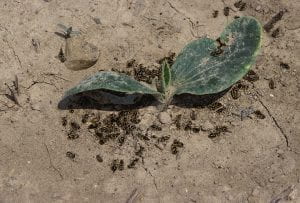If you grow potatoes for profit, chances are you rely on varieties developed by a university-USDA-industry team dedicated to improving your success by improving the varieties available to you. This article outlines aspects of that process and The OSU’s participation in it in 2023, as in more than fifty previous years.
The overwhelming majority of potato varieties used in Ohio and the U.S. are developed by university- and USDA-based programs and teams. These teams are led by breeders-geneticists and include plant pathologists, entomologists, food scientists, horticulturalists, and others working closely with growers, grower organizations, processors, retailers, seed certification programs, and members of industry and government. The small number of teams in the U.S. are based in major production regions, e.g., Northwest North-central, and East, allowing them to develop varieties best suited to these regions. The OSU has cooperated with the Eastern team with breeding programs in Maine, New York, and North Carolina and partners in other states for more than fifty years (see https://neproject.medius.re/ and potato reports at https://u.osu.edu/vegprolab/technical-reports/). The OSU also collaborated with the North-central team with breeding programs in Michigan, Wisconsin, Minnesota, and North Dakota for more than forty years. Regardless of team, working from industry and consumer input, our goal has been to improve marketable yield regardless of production constraints (e.g., disease, nematode, abiotic stress), tuber quality (including sensory properties and nutritional value), crop use of natural resources (e.g., water, fertilizer) and other characteristics. Efforts completed here continue to benefit growers, processors, retailers, chefs, consumers, and others in Ohio and throughout the Eastern U.S.
Potatoes are clonally propagated – i.e., tubers are clones of their mother plant. This means that increasing the availability of seed for a new superior variety can be more straightforward than in crops requiring true botanical seed. However, in its early stages, potato breeding requires creating and evaluating experimental lines resulting from ‘hybridizing’ crosses, e.g., as in tomato variety development. Many crosses are unproductive while others result in experimental lines worthy of additional evaluation under a wide range of conditions. That is when a network of collaborating evaluators operating in various environments where the experimental line/new variety could be grown commercially becomes essential.
In 2023, The OSU will evaluate 126 experimental selections against 12 standard varieties. As before, selections from the University of Maine, Cornell University, USDA-ARS in Maine, and North Carolina State University will be featured and our evaluation process will focus on the interests of growers, processors, retailers, chefs, and consumers. Plots are located at the OSU-Wooster/OARDC and can be viewed anytime. If possible, please contact Matt Kleinhenz ahead of time so he can welcome you properly and help you benefit fully from the tour (kleinhenz.1@osu.edu, 330.263.3810). Also, seed is available to growers who wish to evaluate experimental selections on their farms.
A subset of the information that will be collected for each experimental line through November-2023 is listed below.
Before Harvest
1. Percent stand (# seed pieces planted versus number of plants established)
2. Plant maturity
3. Tuber bulking period
After Harvest
4. Total yield
5. Percent tubers greater and less than 2 inch in diameter
6. Percent of tubers that are misshapen or have a similar market defect
7. Basic tuber characteristics (9 options for each of the following six characteristics – 531,441 possible combinations!): a) skin color, b) skin texture, c) shape, d) flesh color, e) eye depth, and f) uniformity
8. Tuber internal quality (incidence of defects)
9. Specific gravity
10. Chip quality (color, blister), including as chipped directly after harvest or storage (with or without reconditioning). Chip-stock production in Ohio is mainly for situations in which crops are chipped directly after harvest with no storage period.
Regardless of market, on all but a small set of operations, potato vines are removed before harvest either mechanically (quickly) or chemically (slowly). How vines are removed is important to growers and all members of the potato value chain. They all want tubers well suited to a specific end use; however, some varieties may respond less desirably to quick, mechanical vine killing, especially if vines have not died naturally or are not actively senescing. Applying a desiccant that kills the vines slowly and promotes tuber skin set and stolon detachment is most common. However, some growers may choose or be required to harvest crops “green,” when vines have not died or have been chopped very recently, a typical approach to mechanical vine killing. Importantly, vine killing methodology can affect the condition of the tubers at harvest and after, during processing, storage, shipment, and preparation. Killing vines quickly and harvesting soon after can influence various tuber properties including: a) stolon attachment, b) skin integrity/scuffing, c) physical damage, d) relative abundance of starch versus reducing sugars, e) incidence of bruises, and f) storability. Buyer and grower tolerances for these issues can be low so identifying lines capable of being harvested “green” and used effectively can be important. Of course, some consumers prefer small “new” tubers with very thin skins so these crops must be handled carefully. Similarly, growers and processors are also keen to discover the optimal storage conditions for experimental lines and new varieties and the extent to which their tubers must be “reconditioned” before use as referenced in https://www.potatogrower.com/2019/03/top-5-factors-to-successful. Through the years, once popular processing varieties were displaced by new ones with less stringent storage-reconditioning requirements, a discovery made during collaborative testing by variety development teams and industry.
As always, the 126 experimental lines will also be evaluated for their resistances to multiple diseases, nematodes, and insect pests by other team members in Maine, New York, Pennsylvania, Virginia, North Carolina, and Florida. Cooking and consumer evaluation tests will be completed.
Information that will be collected before and after harvest is key because plant and tuber characteristics and yield strongly help determine the main end use and market for which a variety is best suited: a) general fresh market, b) specialty fresh market, c) processing (e.g., chip), or d) fresh-processing dual purpose. Of course, this also means the same variety profile also determines which farms and farmers will benefit most from using a new variety. Production for chip and direct-retail markets has increased in Ohio in recent years.
As shown earlier (see https://u.osu.edu/vegnetnews/2023/03/11/how-will-your-yield-and-efficiency-increase-this-season/), U.S. potato yields have climbed steadily for more than a century. This increase is due to better varieties and crop management. Regardless of your market, if potatoes are part of your business, it can be essential to watch for and test new varieties since they provide the greatest reward for your high-level skill as a grower. As much as possible, take advantage of that skill by using superior varieties instead of relying on it to overcome weaknesses of inferior ones. Future related articles will provide information specific to obtaining seed for new or “alternative” varieties that may benefit your business.










